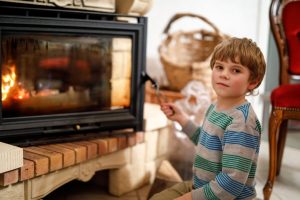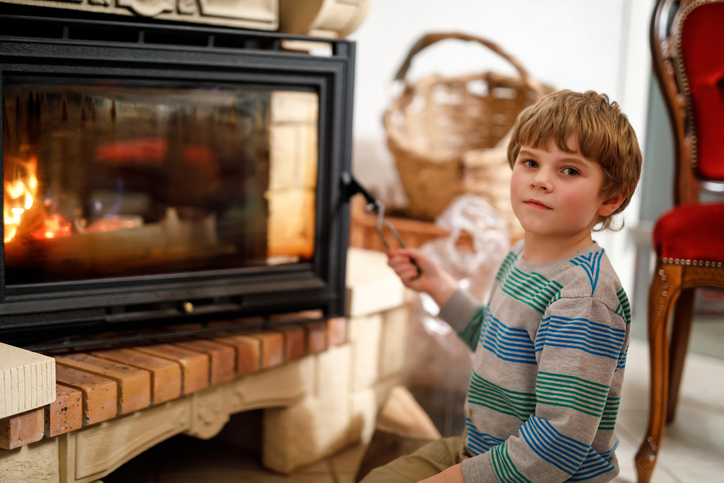
On average, there are 354,400 home fires a year, which is why teaching children fire safety is so important. It might not happen to you, but it’s important to teach your kids how to be safe in a fire. Fire safety for kids is there to make sure they know how to react in a crisis that hopefully will never happen to you.
Teaching Children Fire Safety: HELP YOUR CHILD SURVIVE A FIRE
A major part of fire safety is teaching your kids about how to survive a fire. Make sure you follow each of these steps to help your kid know how to make it out of your home if it catches on fire—and stay out.
SMOKE ALARMS
You should test and replace batteries in your smoke alarms at least once a year. When you test them, it’s a perfect time for you to teach your kids about what a fire alarm sounds like, and what to do when a fire alarm goes off. Involve your kids in replacing the batteries in your smoke alarms throughout your house to help them better understand what smoke alarms are and their role in fire safety.
FIRE DRILLS
Fire drills shouldn’t be only an excuse to get out of a test in your history class, and should be used in your home. When you talk to your kids about how to leave the house when a smoke alarm goes off, make it more than just a lecture. Have practice fire drills to show them, and let them practice how to get low and go.
TOUCH DOOR AND CHECK FOR HEAT
Managing fire safety and getting away from fire can be easier when there’s a straight shot to an exit or it’s easy to identify where the fire is located in the house, but in reality, it’s not always that straightforward. An important skill everyone should know is learning how to check for heat. This should include checking for heat at doors by grabbing a towel or piece of clothing to avoid getting burnt and seeing if a handle or knob is warm. If the door is warm, that means the fire is on the other side and it is not safe to travel through and a different route should be used.
TWO ESCAPE ROUTES
Part of the practice should include getting out of each room in two ways. Sometimes getting low and crawling through the house is not the fastest or safest way out of a room. Learning how to open a window, take out the screen, and exit through the window is an important skill for your kids to learn and practice.
If you live in a home that has barred windows and doors, make sure at least one window in each sleeping room has a release device, and show your kids how to use them. While your home security is important, you should never bar, gate, or lock windows in a way that makes it impossible to escape in an emergency.
BLIND ESCAPE
Where there’s fire there’s smoke, and part of your emergency plan around how to survive a fire should include how to deal with the smoke. Children need to practice how to get out of the house and follow a planned escape route, but they should also be prepared to do it without being able to see.
One of the best ways to practice this is to make it a game. Using a blindfold, you can time them to see how well they can get out without looking. Remember, even though this game focuses on them being blindfolded, they should still use everything they’ve learned up to this point. They should still get low and try to crawl under the smoke, check doors for heat, and know their escape routes.
STOP, DROP, AND ROLL
This simple reminder for kids helps them extinguish any flames if their clothes catch on fire. While it is a popular thing to teach, it is often confusing for kids to remember when they need to stop, drop, and roll. Remember to emphasize this is only an option when their clothing catches fire, not when they get burnt by a hot object or a smoke alarm goes off.
Practice stop, drop, and roll with your kids until it becomes second nature. When a person’s clothing catches on fire, the reaction to stop, drop, and roll, should be instinctive and immediate.
FIRE PREVENTION STARTS WITH YOU
Thanks to Smokey the Bear, we know that only you can prevent forest fires, but it’s also true with fire prevention in your home. Teaching children fire safety ensures you and your kid’s safety at home.
- Keep children three feet away from anything that can get hot. This includes obvious things like stove-tops, ovens, and heaters, but should also include irons, straighteners, hot glue guns, and any open flames.
- Keep smoking materials locked up. If you are a smoker, you need to protect your children from any lighters or matches. Make sure they can only be accessed by adults.
- Never play with lighters or matches. You need to demonstrate and show respect for fire if you expect your children to follow. If you are irresponsible or lazy with fire, your children might try to replicate what they see you do.
ACS SECURITY CAN HELP
Fire safety for kids can go a long way in teaching them the basics, but it’s always nice to know there’s someone else in your family’s corner to make sure you’re staying safe. At ACS Security, we are here to help you with a fire alarm and carbon monoxide monitoring system. The instant your home is in danger, our monitored home control systems make sure first responders are quickly alerted to the emergency no matter if you’re awake, asleep, or even away from home. Contact us to get in touch with a security alarm specialist to find out how we can help your family stay safe.

